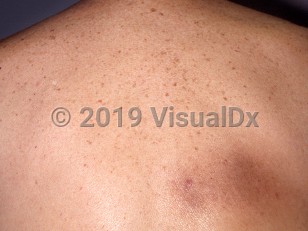Notalgia paresthetica
Alerts and Notices
Important News & Links
Synopsis

Notalgia paresthetica is a condition of the skin of the upper back with extreme pruritus in a localized area just below or medial to the scapula. Notalgia paresthetica is felt to be secondary to spinal nerve impingement, causing a sensory neuropathy and persistent itch. Pain, paresthesias, and hyperesthesias may coincide with the itch. Hyperpigmented or lichenified skin changes, if present, are due to chronic rubbing and scratching of the affected area.
Notalgia paresthetica is relatively common but perhaps underdiagnosed. It can affect people of any age, any race, and either sex. However, it is thought to be most common in middle-aged to older adults. Women seem to develop notalgia paresthetica more frequently than men. A higher body mass index has been associated with longer disease duration.
A related entity is macular amyloidosis, which can also be caused by chronic rubbing. Both notalgia paresthetica and macular amyloidosis can be cutaneous markers of multiple endocrine neoplasia type 2, or Sipple syndrome, especially if onset is during childhood or adolescence.
Although the etiology of notalgia paresthetica is not entirely certain, some studies have demonstrated, radiographically, degenerative changes of the spine corresponding to the level of the nerve root affecting the pruritic skin, typically T2-T6. The posterior rami of T2-T6 have a perpendicular anatomical course through the multifidus spinae muscle, which may predispose them to entrapment and injury.
Notalgia paresthetica is relatively common but perhaps underdiagnosed. It can affect people of any age, any race, and either sex. However, it is thought to be most common in middle-aged to older adults. Women seem to develop notalgia paresthetica more frequently than men. A higher body mass index has been associated with longer disease duration.
A related entity is macular amyloidosis, which can also be caused by chronic rubbing. Both notalgia paresthetica and macular amyloidosis can be cutaneous markers of multiple endocrine neoplasia type 2, or Sipple syndrome, especially if onset is during childhood or adolescence.
Although the etiology of notalgia paresthetica is not entirely certain, some studies have demonstrated, radiographically, degenerative changes of the spine corresponding to the level of the nerve root affecting the pruritic skin, typically T2-T6. The posterior rami of T2-T6 have a perpendicular anatomical course through the multifidus spinae muscle, which may predispose them to entrapment and injury.
Codes
ICD10CM:
R20.2 – Paresthesia of skin
SNOMEDCT:
277802001 – Notalgia paresthetica
R20.2 – Paresthesia of skin
SNOMEDCT:
277802001 – Notalgia paresthetica
Look For
Subscription Required
Diagnostic Pearls
Subscription Required
Differential Diagnosis & Pitfalls

To perform a comparison, select diagnoses from the classic differential
Subscription Required
Best Tests
Subscription Required
Management Pearls
Subscription Required
Therapy
Subscription Required
References
Subscription Required
Last Reviewed:08/05/2018
Last Updated:08/05/2018
Last Updated:08/05/2018
 Patient Information for Notalgia paresthetica
Patient Information for Notalgia paresthetica
Premium Feature
VisualDx Patient Handouts
Available in the Elite package
- Improve treatment compliance
- Reduce after-hours questions
- Increase patient engagement and satisfaction
- Written in clear, easy-to-understand language. No confusing jargon.
- Available in English and Spanish
- Print out or email directly to your patient
Upgrade Today


